You’ve found a parking spot…now comes the tricky part: the parking machine. One wrong button press or an expired coin can mean a ticket instead of a smooth exit.
This guide walks you through every step, whether at a street meter, a garage kiosk, or a digital pay-by-plate terminal. We’ll cover payment options, ticket retrieval, and quick fixes if something goes wrong. By the end, you’ll handle any parking machine like a pro. Keep reading.
What Exactly is the Parking Machine (The Basics)
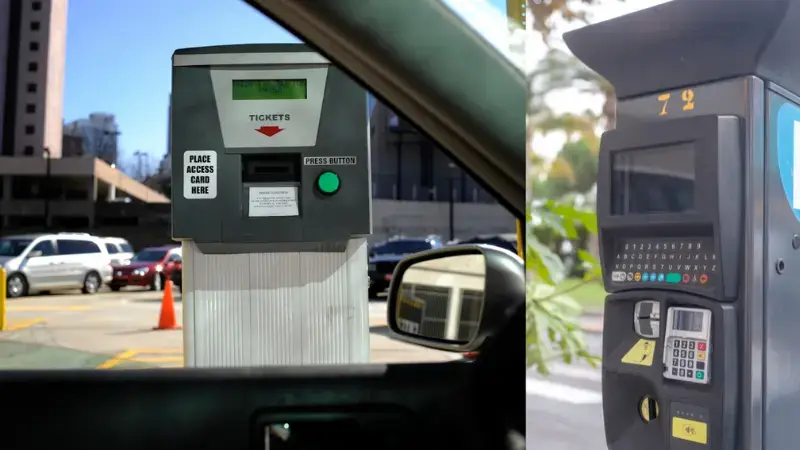
Gone are the days of tossing coins into an old-school meter or handing cash to a booth operator. Parking machines have largely replaced them.
These devices allow you to pay for parking without interacting with anyone. Just follow a few steps. Pay your fee. And you’re done.
Why Should You Prefer a Parking Machine
Parking machines sav e time, reduce errors, and offer multiple payment options. You don’t have to fumble for coins anymore…most take cards or mobile apps.
Many even remember your plate number and store your payment digitally, so there’s no need for a paper ticket.
Common Types of Parking Machines
There are various types of parking machines, each serving a distinct purpose and doing a specific job. Read the following types so you know what to expect before you reach for your wallet or phone.
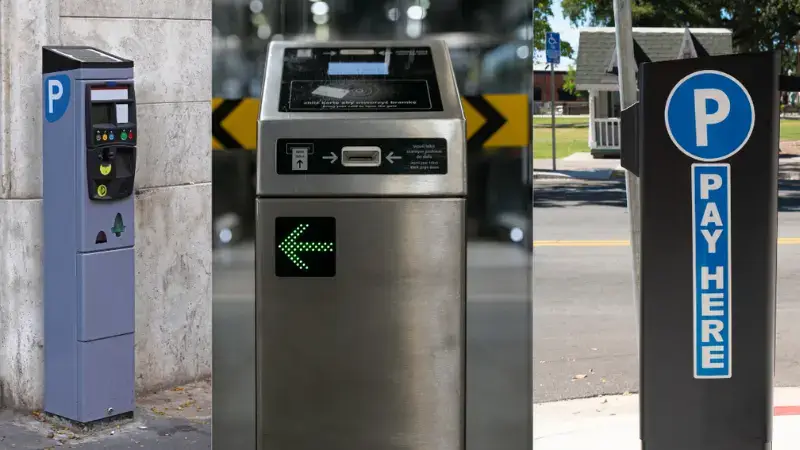
- Pay-and-Display Machines (Ticket-on-Dash)
These are the machines where you pay upfront for a set amount of time. You get a printed ticket and place it on your dashboard.
They’re usually found on city streets or open-air parking lots.
They accept coins, cards, or sometimes mobile payments. The key thing is that you must return before your time runs out, or you risk a fine. Also, always make sure the ticket is clearly visible on your dashboard…face-up and not tucked behind the windshield tint.
Good for: short-term parking, downtown streets, and places without license plate tracking.
- Garage Entry/Exit Ticket Machines
These are the systems where you take a ticket at the entrance gate of a parking garage. Your time starts when you enter. When you’re ready to leave, you insert that ticket into a kiosk, pay the total, and then use it to open the exit gate.
They work well in busy areas such as garages, airports, malls, or office buildings, where people stay for varying durations.
Lost your ticket? There’s usually a “lost ticket” button, but be ready to pay the maximum fee.
Good for: long-term stays, secured indoor garages, and gated private lots.
- Parking Kiosk (Touchscreen, multi-payment, often license-plate based)
These modern machines ask you to enter your license plate number at the kiosk when paying. There’s no paper ticket to display. Your plate is your proof of payment. Officers scan your plate to check if you’ve paid.
They typically offer multiple payment methods, including cards, mobile apps, tap-to-pay, and QR code scanning.
If you mistype your plate number, your payment won’t be processed, so always double-check before confirming.
Good for: large lots, smart city areas, and places moving away from paper tickets.
- Vending-Style Ticket Dispensers (Flat rate or short-term)
These machines are super simple. You insert your money, get a flat-rate ticket, and park. There’s no need to enter how long you’ll stay or your license plate. The rate is usually fixed—such as $5 for two hours or $10 for the entire day.
They’re often used in places with predictable foot traffic, like hospitals, concert venues, or sports arenas. The focus here is on speed and ease, rather than time tracking.
Good for: quick entry/exit, short-term parking, or events with a single entry fee.
Core Functions of a Parking Machine You Need to Know
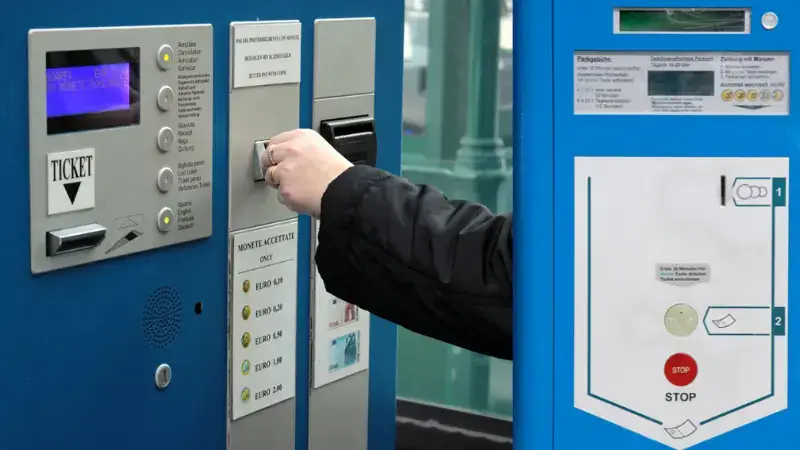
Parking machines may vary in appearance, but they all serve the same basic functions. If you understand these core functions, you’ll never feel lost, no matter what kind of machine you’re using.
- Accepting payment (cash, card, mobile)
Most machines take coins, credit/debit cards, and mobile payments like Apple Pay or Google Pay. Some still only accept cash, while others are fully digital with no coin slots.
Check the payment symbols before getting in line to save time and avoid stress.
- Printing or digital confirmation
After you pay, the machine gives either a paper ticket or a digital confirmation.
If it’s a paper ticket, place it on your dashboard, if it’s digital, your license plate confirms payment—no printing needed.
Always check the screen before leaving to ensure your payment has gone through.
- Validating time/rate/location
The machine sets your parking time based on your payment and local rules. It also considers:
- Time limits in the area
- Flat or hourly rates
- Zone rules (such as maximum time allowed)
Check the signs nearby before paying—some spots limit parking during business hours.
- License plate-based systems
Modern kiosks often require you to enter your license plate number before payment. This ties your parking session to your vehicle. No physical ticket is needed.
Double-check your plate number before confirming—one small mistake could lead to a fine, even if you paid.
How to Use a Parking Machine or Kiosk (Step-by-Step)
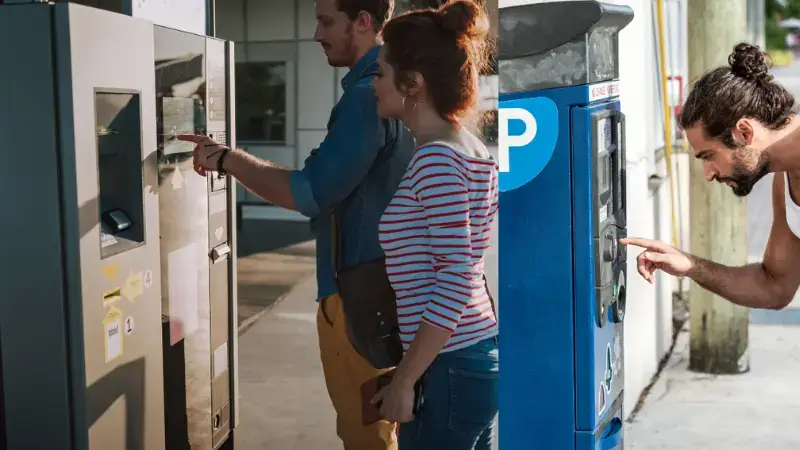
Using a parking machine isn’t complicated, but missing a key step can still result in a fine.
Stick to these steps to handle the process smoothly and avoid parking mistakes.
1. Find the Right Machine for Your Spot
Street parking typically uses either pay-and-display or pay-by-plate systems, while garages often include gated entry machines and kiosks located near exits.
Scan the signs posted near your space. They’ll indicate:
- The zoning code (especially important if using a parking app)
- Any time-based rules or restrictions
- Whether the system requires a printed ticket or is linked to your license plate
2. Choose Payment Type
Before inserting coins or tapping your card, take a moment to review the machine’s supported payment methods.
While some still operate on a cash-only basis, many accept cards, contactless options, or mobile app transactions.
Watch for stickers or on-screen instructions showing which options are available. Older units may use physical buttons instead of a touchscreen.
If paying via the app, either scan the machine’s QR code or enter the posted zone number manually.
3. Enter Duration or License Plate
Next, your action depends on the type of machine in use:
- For pay-and-display units, select your desired parking time using the +/– controls or digital prompts.
- For pay-by-plate systems, you’ll need to enter your license plate number accurately—errors here may cause verification issues or penalties.
Make sure your input is correct before moving forward.
4. Confirm and Pay
Now you’re ready to process payment.
- If using cash, flatten any wrinkled bills, as some machines may reject damaged currency or limit the types of coins that are accepted.
- When using a card, insert or tap as instructed, and wait for confirmation before removing it to avoid incomplete transactions.
- If using an app, verify the zone number carefully before confirming payment; digital receipts may be available depending on the system.
Always wait for the machine to confirm success before walking away.
5. Retrieve Ticket or Confirmation
Once payment is complete, the machine will either print a paper ticket or display a digital confirmation.
If you receive a ticket, place it clearly on your dashboard, facing up and free of obstructions.
If no ticket prints, your plate number has likely been recorded electronically, so displaying proof isn’t required.
In parking garages, keep your ticket handy, as exit gates may require it for validation.
Street Parking vs. Garage Machines: What’s Different?

What separates street parking from garage setups is more than just location—it’s how the system works, how you pay, and how rules are enforced.
Garage Parking Systems
These operate with entry gates. A ticket is issued when you drive in, and your total fee is calculated based on the duration of your stay. Payment is completed before exiting. In some garages, parking can be validated by nearby businesses.
Street Parking Machines
These machines are found curbside or in designated zones; these systems require no physical barrier. After parking, you must locate a nearby machine or use an app to pay. Depending on the setup, you’ll either input your license plate or print and display a ticket.
Comparison Table: Garage vs. Street Parking Machines
| Feature | Garage Parking Machines | Street Parking Machines |
|---|---|---|
| Location | Indoor or multi-level parking garages | Curbside, outdoor, or surface-level lots |
| Access Control | Entry/exit gates with ticket or license plate scan | No gates; open access |
| Start of Session | Ticket issued at the entry gate or plate scanned | Pay at the machine/app after parking |
| Payment Time | Pay before exiting at the kiosk or the exit gate | Pay immediately after parking |
| Ticket Type | Paper ticket or plate-based system | Pay-and-display ticket or pay-by-plate |
| Validation Option | Often available at businesses | Rarely available |
| Enforcement Method | Gate won’t open without payment | License plate scan or check for a dashboard ticket |
| Common Payment Methods | Cash, card, digital wallet | Card, app, coins, sometimes cash |
Advanced Features in Modern Parking Kiosks
Today’s parking machines are faster, more efficient, and built for modern user needs.
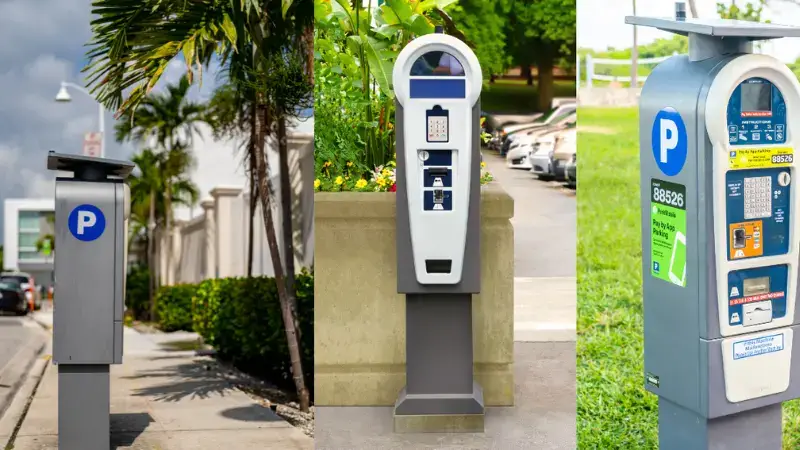
Touchless & Contactless Systems
Many upgraded kiosks now offer multiple ways to pay without physical contact, including:
- Tap-to-pay using NFC-enabled cards
- Mobile wallets such as Apple Pay and Google Pay
- App-based payments through QR code scanning
These systems gained popularity during the COVID-19 pandemic, and many busy cities now rely on app-only setups to reduce physical contact and speed up transactions.
License Plate Recognition (LPR)
Some kiosks have eliminated paper tickets altogether. These machines:
- Use cameras to scan your plate at entry and exit automatically
- Match the plate number to a digital payment in the system
You won’t need to print a receipt or walk back to your car. This setup is commonly found in tech-driven garages and private lots.
Multilingual and Accessibility Options
Modern kiosks are designed to accommodate a broader range of users by offering features like:
- Large, high-contrast text that improves screen visibility in different lighting conditions
- Audio guidance and screen reader support for people with visual impairments
- Menu options in multiple languages—especially helpful in tourist areas
These tools usually appear on the startup screen. If they’re unavailable or challenging to navigate, the mobile parking app often offers better and more adaptable accessibility settings.
Troubleshooting Common Parking Machine Issues
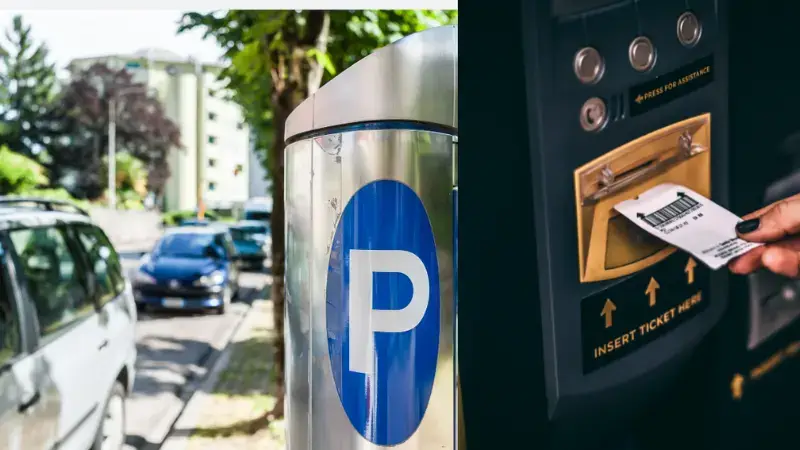
Even the most dependable machines can malfunction, but knowing how to respond helps you stay on track and avoid unexpected fines.
Card Payment Not Working
If your card is declined, first try another one. Some machines are unreliable due to worn-out components, but contactless payments, such as tap (NFC), often work more smoothly. Older kiosks may lack tap features, so check the display for payment options. If all else fails, consider switching to coins or using a mobile parking app, provided the zone allows it.
The Machine Isn’t Printing a Ticket
Sometimes the machine needs a moment…wait a few seconds before assuming it’s broken.
If no ticket prints, look for signs of a paper jam or a blinking error icon.
Most machines have a “Help” or “Assistance” button. Use it to get immediate support. If the machine remains unresponsive, locate another kiosk nearby or switch to the app if it supports the zone.
Can’t Find a Machine Near My Car
This is common in street parking zones. Start by checking nearby signs for a zone number. They’ll often point you in the direction of the correct machine.
Typically, one kiosk serves an entire side of the street, so it won’t always be within sight. Parking apps can detect your location and zone, making it easier to pay without having to walk around to find a machine.
Out-of-Service Machine
If the screen is blank or displays an error, find the nearest machine or pay via the app if the area supports it.
Always report broken kiosks by noting the machine’s ID or nearby street address. This helps the city repair it and can also support any fine disputes later.
Don’t assume you’re exempt just because it’s out of service—without proof of payment or an attempt, you still risk a citation.
Tips for Faster, Stress-Free Parking

A little prep can save you from fines and frustration. These simple habits can make parking smoother every time.
- Use a parking app whenever possible. You can pay, extend time, and even find nearby machines…all from your phone.
- Take a quick photo of the payment sign or your ticket. It’s proof in case there’s a dispute.
- Set a phone alarm for 5–10 minutes before your session ends, so you’re not caught off guard.
- Learn your local setup: Some areas use pay-by-plate, while others require a ticket to be displayed. Knowing the system avoids mistakes.
- Avoid using crumpled bills or foreign coins. They often jam machines.
FAQs About Using Parking Machines
Q1: Can I pay for parking with my phone?
Yes, most urban parking zones now support mobile apps such as ParkMobile or PayByPhone. Simply launch the app, enter the zone number, and link it to your license plate to begin.
Q2: What should I do if I lose my garage parking ticket?
Visit the help kiosk or speak with an attendant at the exit gate. Without a ticket, you may be charged the full daily rate unless your entry time can be verified.
Q3: Do all parking kiosks accept credit or debit cards?
No. Although most updated machines do, older kiosks may only accept coins or paper cash. Always check the accepted payment methods before attempting to pay.
Q4: Are paper tickets still necessary with plate-based systems?
Usually not. License plate recognition logs your vehicle’s entry and payment digitally unless signage or prompts specifically require a printed receipt.
Q5: How can I tell if a printed ticket must be displayed?
Look at nearby parking signs and follow machine instructions. In pay-and-display zones, the ticket must be clearly visible on your dashboard to confirm payment.
Final Thoughts
Parking shouldn’t feel like a guessing game or a time trap. Yet, most people still struggle with outdated machines or confusing systems every day. What if your city, business, or facility could offer a faster, clearer, and frustration-free way to manage parking?
Swiftforce builds kiosks designed for real-life use. Intuitive. Reliable. Modern.
Ready for Smarter Parking?
Explore Swiftforce parking kiosk solutions and see how much smoother parking can be…for everyone. If you have any questions, please contact us.



